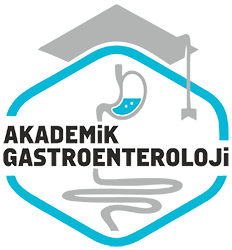Agustos 2017
karaciğer sirozlu 225 hastanin retrospektif irdelenmesi: Tek merkez deneyimi
Retrospective analyses of 225 patients with liver cirrhosis: A single center experience
- Ana Sayfa
- Sayılar
- Agustos 2017
- karaciğer sirozlu 225 hastanin retrospektif irdelenmesi: Tek merkez deneyimi...
Özet
Giriş ve Amaç: Bu çalışmanın amacı klinigimizde yatmis olan karaciger sirozlu hastalarimizin yatış endikasyonlarini ve genel özelliklerini irdelemektir. Gereç ve Yöntem: Bu çalışmada, Aralık 2011 ve Mayis 2013 tarihleri arasında klinigimizde yatan 255 hasta retrospektif olarak değerlendirilmıştır. çalışmaya alinma kriterleri; hastanede yatmis olmak, yatış öncesinde veya yatış sırasında karaciger sirozu tanısı almis olmak, 18 yaş üstü olmak ve tibbi verilerine tam olarak ulasilabiliyor olmak iken dislama kriterleri ise; ayaktan basvuran hastalar, siroz dışı portal hipertansiyon varligi, 18 yaş altı olmak ve tibbi verilerinde eksıklık olmasi olarak belirlenmıştır. Bulgular: Otuz hastanın verileri tam olmadigi için çalışmadan dislanmis olup çalışmaya 225 hasta dahil edilmıştır. Hastaların çogunu erkekler (%70.2) olustururken erkeklerin ortalama yaşi 62, kadınlarin ortalama yaşi 67 bulunmustur. Baslica yatış nedenleri ileri Girişimsel tedavi amacıyla hepatosellüler kanser (%21.8), hepatik ensefalopati (%21.3), asit etiyolojisini araştırmak (%20.4) ve varis kanaması (%13.8) olarak tespit edilmıştır. Etiyolojileri incelendiginde hepatit B virüsü ilk sirayi alirken (%32.8), bunu sırasıyla hepatit C virüsü (%21.3), kriptojenik (%20) ve alkole bagli nedenler (%18.2) izlemıştır. Hastalarimizin çogunda (%83.6) varis saptanmıştır. Hastalarimizin büyük bölümünü (%77.3) Child-Turcotte-Pugh skoru B ve C hastalari olusturmus, büyük bir çogunlugunda (%64) asit saptanmıştır. Asitli olgularin %95’inde serum asit albümin gradientinin ?1.1 olduğu görülmüstür. Asit ponksiyonu yapılan hastalarimizin %8’inde spontan asit enfeksiyonu saptanmis, büyük bir çogunlugunun (%65) kültür negatif nötrositik asit olduğu görülmüstür. Toplamda 26 (%11.6) hasta yattigi süre içerisinde kaybedilmıştır. Sonuç: Üçüncü başamak Sağlık merkezi olan hastanemizde hepatosellüler karsinomaya uygulanan Girişimsel tedavi islemleri siroz Hastalarında en önemli yatış nedenlerinden birisi haline gelmıştır.
Abstract
Background and Aims: The aim of this study was to evaluate our hospitalized patients with liver cirrhosis regarding hospitalization indications and general features. Materials and Methods: Two hundred and fifty-five patients with cirrhosis who were hospitalized between December 2011 and May 2013 were evaluated retrospectively in this study. The inclusion criteria were history of hospitalization, diagnosis either before or during hospitalization, being older than 18 years of age and having complete medical data. The exclusion criteria were outpatient cases, presence of noncirrhotic portal hypertension, being younger than 18 years of age, and having incomplete medical data. Results: Thirty patients were excluded from the study due to insufficient medical data; hence, the study included 225 cases. Most patients were male (70.2%), and the mean age was 62 years for males and 67 years for females. The most frequent hospitalization indications were hepatocellular carcinoma for further interventional treatments (21.8%), hepatic encephalopathy (21.3%), ascites of unknown etiology (20.4%), and variceal bleeding (13.8%). The etiological factors for cirrhosis were hepatitis B virus (32.8%), hepatitis C virus (21.3%), cryptogenic (20%), and alcohol (18.2%). Varices were found in most patients (83.6%). Most patients were in Child-Turcotte-Pugh classes B and C (77.3%). The majority of patients (64%) had ascites. The serum-ascites albumin gradient was ?1.1 in 95% of patients with ascites. Spontaneous ascites infection was found in 8% of patients who underwent ascitic fluid examination, and mostly cultured negative for neutrocytic ascites (65%). Overall, 26 (11.6%) patients died during hospitalization. Conclusion: Interventional treatments for hepatocellular carcinoma has become one of the most important hospitalization indications for patients with cirrhosis in our tertiary medical center.



